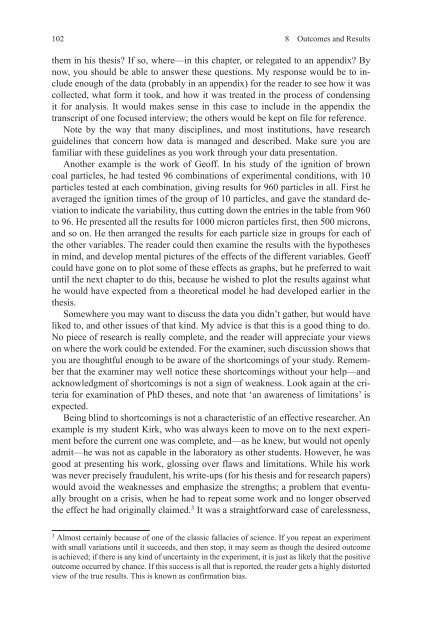How-to-Write-a-Better-Thesis
Create successful ePaper yourself
Turn your PDF publications into a flip-book with our unique Google optimized e-Paper software.
102 8 Outcomes and Results<br />
them in his thesis? If so, where—in this chapter, or relegated <strong>to</strong> an appendix? By<br />
now, you should be able <strong>to</strong> answer these questions. My response would be <strong>to</strong> include<br />
enough of the data (probably in an appendix) for the reader <strong>to</strong> see how it was<br />
collected, what form it <strong>to</strong>ok, and how it was treated in the process of condensing<br />
it for analysis. It would makes sense in this case <strong>to</strong> include in the appendix the<br />
transcript of one focused interview; the others would be kept on file for reference.<br />
Note by the way that many disciplines, and most institutions, have research<br />
guidelines that concern how data is managed and described. Make sure you are<br />
familiar with these guidelines as you work through your data presentation.<br />
Another example is the work of Geoff. In his study of the ignition of brown<br />
coal particles, he had tested 96 combinations of experimental conditions, with 10<br />
particles tested at each combination, giving results for 960 particles in all. First he<br />
averaged the ignition times of the group of 10 particles, and gave the standard deviation<br />
<strong>to</strong> indicate the variability, thus cutting down the entries in the table from 960<br />
<strong>to</strong> 96. He presented all the results for 1000 micron particles first, then 500 microns,<br />
and so on. He then arranged the results for each particle size in groups for each of<br />
the other variables. The reader could then examine the results with the hypotheses<br />
in mind, and develop mental pictures of the effects of the different variables. Geoff<br />
could have gone on <strong>to</strong> plot some of these effects as graphs, but he preferred <strong>to</strong> wait<br />
until the next chapter <strong>to</strong> do this, because he wished <strong>to</strong> plot the results against what<br />
he would have expected from a theoretical model he had developed earlier in the<br />
thesis.<br />
Somewhere you may want <strong>to</strong> discuss the data you didn’t gather, but would have<br />
liked <strong>to</strong>, and other issues of that kind. My advice is that this is a good thing <strong>to</strong> do.<br />
No piece of research is really complete, and the reader will appreciate your views<br />
on where the work could be extended. For the examiner, such discussion shows that<br />
you are thoughtful enough <strong>to</strong> be aware of the shortcomings of your study. Remember<br />
that the examiner may well notice these shortcomings without your help—and<br />
acknowledgment of shortcomings is not a sign of weakness. Look again at the criteria<br />
for examination of PhD theses, and note that ‘an awareness of limitations’ is<br />
expected.<br />
Being blind <strong>to</strong> shortcomings is not a characteristic of an effective researcher. An<br />
example is my student Kirk, who was always keen <strong>to</strong> move on <strong>to</strong> the next experiment<br />
before the current one was complete, and—as he knew, but would not openly<br />
admit—he was not as capable in the labora<strong>to</strong>ry as other students. <strong>How</strong>ever, he was<br />
good at presenting his work, glossing over flaws and limitations. While his work<br />
was never precisely fraudulent, his write-ups (for his thesis and for research papers)<br />
would avoid the weaknesses and emphasize the strengths; a problem that eventually<br />
brought on a crisis, when he had <strong>to</strong> repeat some work and no longer observed<br />
the effect he had originally claimed. 3 It was a straightforward case of carelessness,<br />
3<br />
Almost certainly because of one of the classic fallacies of science. If you repeat an experiment<br />
with small variations until it succeeds, and then s<strong>to</strong>p, it may seem as though the desired outcome<br />
is achieved; if there is any kind of uncertainty in the experiment, it is just as likely that the positive<br />
outcome occurred by chance. If this success is all that is reported, the reader gets a highly dis<strong>to</strong>rted<br />
view of the true results. This is known as confirmation bias.














![[Lonely Planet] Sri Lanka](https://img.yumpu.com/59845622/1/169x260/lonely-planet-sri-lanka.jpg?quality=85)


